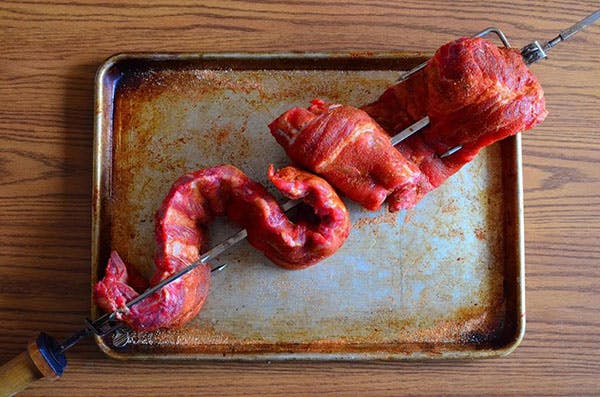Tags:
- Rotisserie
- Ribs
Official Weber Website
Why rotisserie ribs? It’s a lot of work to get them on the spit - you have to bend them back and forth, working the spit between the bones. But I get my best ribs this way. They’re tender on the inside, with a crispy crust from the self-basting action of the rotisserie. (That’s right - the spinning of the spit bastes the ribs in pork fat while they cook.)
I save my homemade barbecue sauce for the last 15 minutes of cooking. There’s a lot of sugar in barbecue sauce, and I don’t want it to burn in the heat of the grill…but want it to have at least some cooking time, to thicken it up into a glaze on the ribs. And, just for fun, my homemade barbecue sauce has a secret ingredient: a shot of coffee. That’s right, these ribs have a little wake-me-up in the sauce.

Ingredients
Smoking wood
2 fist sized chunks smoking wood (charcoal grill), or 2 cups soaked wood chips (gas grill)
Ribs
2 (3-pound) slabs baby back ribs (“extra meaty” if you can find them)
Rub
2 tablespoons paprika
2 tablespoon kosher salt
1 tablespoon sugar
2 teaspoons mustard powder
2 teaspoons garlic powder
Red-eye barbecue sauce (or substitute store-bought sauce)
15 ounces ketchup
1/2 cup brown sugar
1/4 cup cider vinegar
1/4 cup coffee
1 tablespoon Dijon mustard (or substitute cheap yellow mustard)
Skewer the ribs:
First, remove the membrane from the rib side of the slabs. Work the membrane loose from one of the end bones with a butter knife, grab the membrane with a paper towel, and peel it off the ribs. Attach the first spit fork to the spit. Take a slab and run the spit between the first and second bone. Bend the slab of ribs and run the skewer between the fifth or sixth bone. Bend the slab in the other direction, into an “S” shape, and run the skewer between the bones. (Picture a s-curve, or a snake, or see the picture below.) Bend the slab the other way, and run the skewer between the last two bones on the slab. Slide the ribs down and secure them on the spit fork. Repeat with the second slab, pushing the ribs on tight. Make sure the ribs are centered on the spit, then secure the end of the second slab with the other spit fork.
Rub the ribs and make the Red-eye barbecue sauce:
Mix the rub ingredients in a small bowl, then sprinkle evenly over the ribs. (It’s less messy to rub the ribs after they’re on the spit). Whisk the Red-eye barbecue sauce ingredients in a medium bowl until completely mixed.Test the rotisserie:
Set up the rotisserie, put the spit on the grill and turn on the motor. Be sure to test that your food fits and freely spins on the rotisserie. (It is crucial to test this out before you preheat the grill.)Set up the grill for indirect medium-low heat:
Set the grill up for indirect medium-low heat (300°F) with the drip pan in the middle of the grill. For a Weber kettle, light a half-full chimney starter of charcoal, about 50 briquettes. When the coals are covered with gray ash, pour the charcoal in two equal piles on the sides of the grill, and put the drip pan in the middle, between the piles. (Charcoal baskets and a Weber Extra Large Drip Pans make this easy.)
Cook the ribs:
Put the spit on the grill, start the motor spinning, and make sure the drip pan is centered beneath the ribs. Add the wood chunks to the coals. Close the lid, and keep the lid closed as much as possible while cooking. Add 16 unlit briquettes to the coals every hour if you are cooking with a charcoal grill. The ribs are cooked when the meat pulls back from the end of the bones pull back by 1/4 inch and the ribs are nicely browned, about 3 hours. (With baby back ribs, a little extra cooking time never hurts, so err on the side of more cooking.) During the last 15 minutes of cooking, brush the ribs with a thick coat of barbecue sauce every five minutes.Serve:
Remove the ribs from the spit immediately - as they cool down, they stick more to the spit. Transfer the ribs to a platter, cover with aluminum foil, and let the ribs rest for fifteen minutes, then serve. I cut the ribs into serving size pieces – half slabs for big eaters, or between every second bone for smaller servings. Pass the extra barbecue sauce at the table.
Notes:
I use cherry or apple for smoking wood, because they’re local to me - I had a cherry tree that had to come down in my back yard, and I have wood chunks to last for quite a while now. Hickory, oak, and pecan all work well with baby back ribs.
Watch out for shiners on your baby back ribs – ribs where you can see the bone. If you can see the bone, they were cut so close that all the meat is gone. My local grocery store started carrying “extra meaty” baby back ribs a year or two back, and I love them.
No coffee for the sauce? Replace it with more cider vinegar.
Adapted from: Rotisserie Grilling by Mike Vrobel. Visit Mike at his blog, DadCooksDinner.com.